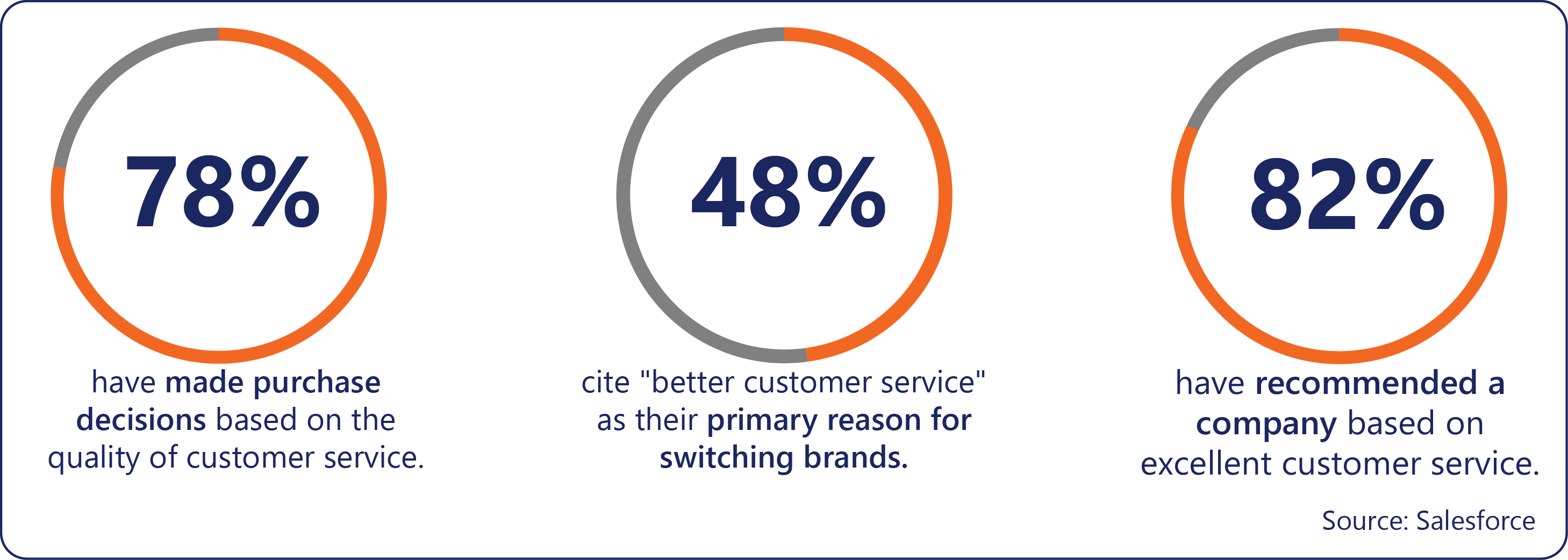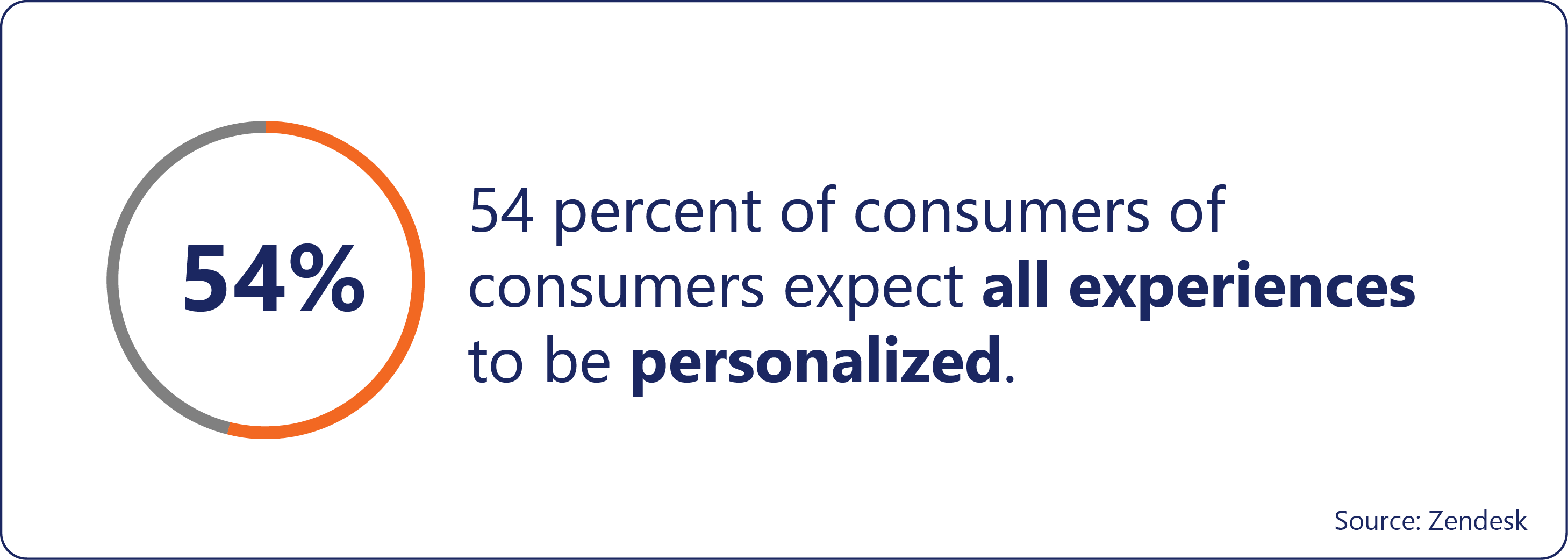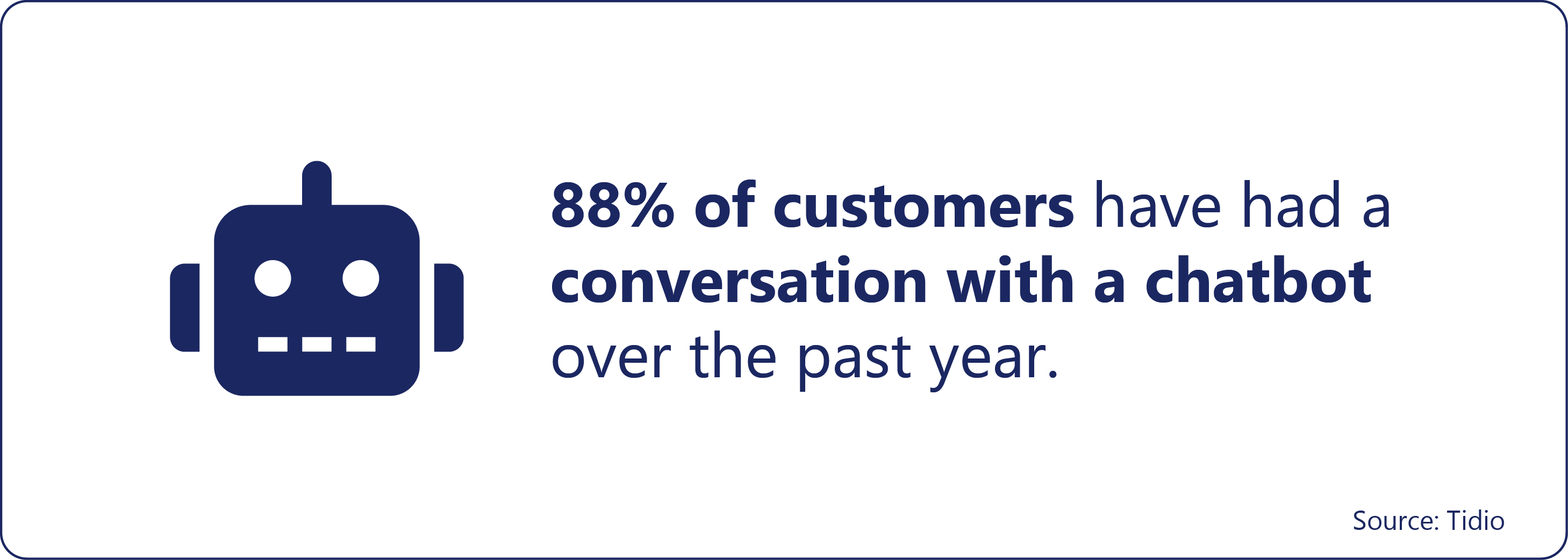8-minute read
Quick summary: By leveraging customer service as a business growth driver, organizations uncover opportunities to increase revenues, improve customer trust and loyalty, and create competitive advantages.
Driven by escalating customer expectations, budgetary pressures to do more with less, and increasingly competitive markets, businesses across several industries are investing to elevate their customer service game. In today’s environment, memorable customer service holds a promise that goes beyond simply reducing costs or increasing efficiency—it increases revenues and fuels business (and brand) growth. Memorable customer experiences have the potential to create a “moat” around businesses and make them more resilient to recessions, pandemics, and market volatility.
In Salesforce’s “State of the Connected Customer” survey, 88 percent of respondents said the experience a company provides is as important as its products and services. Ninety-four percent said they’re more likely to make another purchase after a positive customer service experience. Consider your own history as a customer. What stands out as your favorite customer service experience—online (app or mobile), on the phone, or in person? What makes that interaction memorable?
For our clients in the energy industry, for example, consumer expectations are being shaped by Amazon, Netflix, and other digital transformation trailblazers. Top-tier customer service is not a nice-to-have—it’s a vital revenue driver that can make the difference between business growth and flat or declining revenues.
Customer service as a business growth engine
The role of customer service is evolving from “troubleshooter” to “trusted advisor,” proactively offering customers guidance, information, and assistance in realizing the maximum value from their relationship with the brand. The result: a new class of customer experience that creates new possibilities for increasing customer trust and loyalty, gaining repeat business, and activating additional revenue sources.

Customer service organizations are also a treasure trove of data-driven insights that can be shared with other internal teams to improve products and services, spark innovation, fine-tune sales and marketing efforts, and uncover new competitive advantages.
Returning to the example of our energy utility clients, forward-thinking electricity and gas providers are evolving past their traditional image of brands that customers only think about when their service goes out. Today’s cost-conscious, environmentally aware consumers are looking for ways to optimize their spending, reduce their carbon footprints, and do their part in keeping communities safe—and utility companies are stepping in to help them make an impact.
Customer service: a finger on the pulse of the customer
“What do our customers want and need from us?” This question has driven businesses—large and small, across all industries and geographies—since the dawn of commerce. All along, their customer service organization has had the answers to this question; there just wasn’t an efficient way of translating customer service data into actionable insights. Until now!
Customer service remains a touchpoint for customers throughout their journey with the brand. It’s a constant communication pipeline that speaks volumes about what customers are saying, doing, and thinking. Thanks to master data management, advanced analytics, and AI-driven technologies, businesses can leverage this wealth of information to be proactive, deliver a personalized experience, and drive innovation.
1. Drive innovation across the organization
When businesses treat customer service as a value center, the data-driven insights can flow out to all corners of the organization to help them answer their most pressing questions, including:
• Product development: “How can we improve current products and services or develop new ones that better align with our customers’ needs?”
• Sales and marketing: “How can we fine-tune our approach to sales and marketing to resonate with current and prospective customers?”
• Billing: “What kind of bill pay options do customers want?”
… not to mention the insights that flow back into the customer care organization to enable continuous improvement of the service experience.
Most organizations are familiar with “voice of the customer” initiatives to drive organizational improvements and innovation. Now they can add “voice of service” to the mix, incorporating data that’s grounded in real-world customer interactions.
2. Be proactive
Value-centered customer service focuses on anticipating and addressing issues before they arise. Using advanced analytics and AI, businesses can use the data at their disposal—including data from outside sources—to proactively understand, anticipate, and meet customer needs and to drive proactive services and communications.

Utility companies, for example, can leverage data not only to inform customers that an outage is affecting their area, but also to communicate how many customers are affected, what caused the disruption, and when they expect service to be restored. Not only does this prevent phone calls reporting outages the utility already knows about, but it also enables customers to adjust their activities based on the anticipated duration of the outage.
3. Personalize services and communications
Today’s customers not only expect personalized experiences and recommendations—they have little patience for communications that don’t speak directly to their needs and objectives. By leveraging advanced analytics, utilities can build profiles for each customer—entailing, for example, whether they assign a higher priority to cost savings or to reducing their carbon footprint—and design tailored experiences accordingly.

Bridging the gap with technology
To transform customer service from a cost center to a growth driver, you need well-governed customer data and the technical muscle to spin that data into assets that transform customer experiences.
Master data management (MDM)
Delivering the caliber of service that makes a trusted advisor requires clean, current, reliable customer data that’s readily accessible to the people and applications that need it. Building and implementing a MDM strategy for customer data enables businesses to:
• Identify where customer data resides and who has access to it”
• Ensure data accuracy and eliminate duplicates
• Create a data governance program to ensure reliability
• Build a single source of truth for all customer data
Advanced analytics
Advanced analytics enables organizations to transform raw customer data into actionable insights that can drive an improved customer experience, product innovation, and competitive advantages. To cite one example from the utilities industry, providers can track customers’ normal energy consumption patterns and deliver proactive communications when their usage exceeds normal parameters, potentially forestalling “bill shock” when the next payment date arrives.
AI
Organizations leverage artificial intelligence to build data-fueled platforms for both customers and service agents. For example, …
• Chatbots and “virtual agents” can offer instant answers to frequently asked questions and rapid resolution to common issues such as password resets.
• AI-driven agent dashboards can “listen in” on phone calls and chats and proactively suggest solutions and resources to the agent.
• AI enables businesses to identify patterns in customer data that product teams can use to design new features or create innovative product offerings.

Self-service portals
In addition to simplifying common tasks like bill pay, portals that are powered by advanced analytics and AI enable customers to access personalized recommendations and learn how to get the most value out of their products and services. Utility customers, for example, can use customer portals to monitor their consumption, access energy-saving tips based on their history and usage habits, and explore pricing plan recommendations based on their lifestyles (e.g. whether they have solar panels or drive electric vehicles).
Utilities spotlight: Reinventing customer journeys
Each industry and each organization has its own unique customer journeys, and redefining the role of customer service requires a close look at these journeys—what they are today and what they could be in the future. For utility companies, mapping out ideal journeys for specific customer needs is an important first step in taking on their new role as trusted advisors.
Bill pay
Realistically, monthly bill payments may be the only interactions customers have with their utility providers, so it’s in every utility’s interest to make the experience as positive as possible. Utilities can seize the opportunity to deliver options and communications that enhance the customer experience, such as
• Creating a separate Twitter account for billing inquiries and other account-related questions
• Offering a quick-pay option that requires no login
• Alerting the customer to flexible billing options such as auto-averaging and “choose your own due date”
• Offering 1-click enrollment for paperless billing
• Showing an analysis of the customer’s usage from the previous month compared to a rolling average and offering personalized recommendations for lowering their consumption
Outage communications
Aside from payment of their monthly bills, there’s one other occasion that forces customers to think about their utility providers: when their service goes out. Utilities can use these occasions as opportunities to deepen customer relationships by delivering the information they need and putting on the “trusted advisor” hat to help them get through the disruption:
• Allow customers to sign up for notifications regarding outages via email or text messaging.
• Let customers know when you’re aware of an outage in their area, approximately how many customers it affects, and when you expect service to be restored.
• In case of an extended outage, use your platform to share tips such as limiting opening of refrigerators and freezers to maintain temperature levels.
• Advise customers on how to be prepared for outages (e.g. keeping flashlights with spare batteries readily available) and on what to do in case of an extended outage (e.g. how to use generators safely).
Shaping the future of customer service
Traditionally seen as a cost center—a “necessary evil” (or at least a “necessary neutral”)—customer service is emerging as the next great business growth opportunity. By delivering the proactive, personalized experiences customers expect and building the resulting data into product development and other areas, organizations can reap the benefits of tapping into a source of growth that’s been right in their own backyards all along: their own customers.
Like what you see?

Amit Unadkat is a Senior Manager of Digital Transformation with extensive experience in robotic process automation, virtual assistants, business process optimization, and technical product management. In 2021 he received Built In’s Tech Innovator Award for his work in automation and was recognized as a Rising Star by Consulting Magazine.

Tejan Gabisi is a Director of Advanced Analytics, responsible for overseeing engagements that focus on advanced analytics, digital product development and innovation. He has over 20 years of experience leading cross-functional teams with demonstrated success in developing digital roadmaps across multiple industries including power and utilities, oil and gas, healthcare, financial services and technology.

